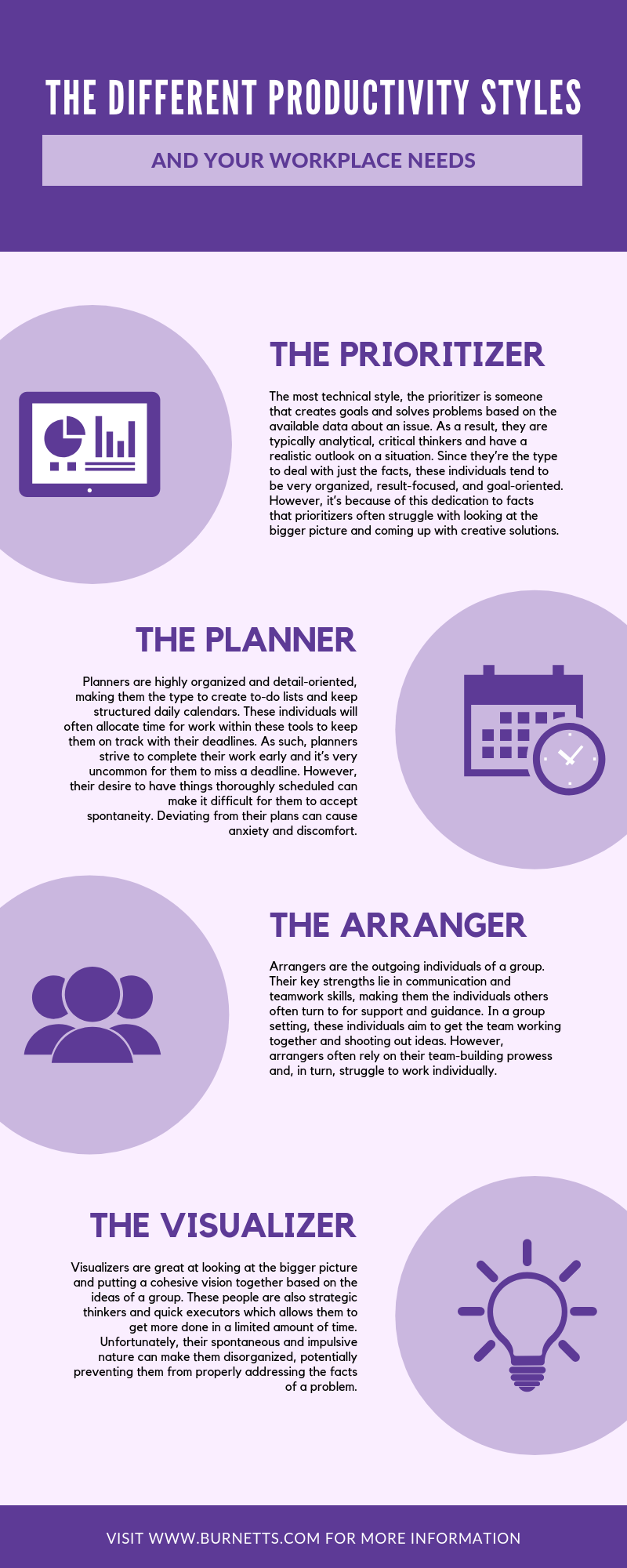
Along with listing several desirable skills on your resume, it’s crucial that you can identify how you work and stay organized. You can apply this personalized work process, defined as a productivity style, to any type of work you do in your life—whether it’s professional or hobbies. These styles offer an understanding of how our minds work and what we each can do to grow our success in various careers. Explore the different productivity styles and decipher which one would best describe you.
The Importance of Productivity Styles
Not every person conducts their work in the same way. While some may find that they need to approach their tasks from a factual perspective, others might need to use imagery to keep themselves focused. These methods, among others, are entirely dependent on your personal way of focusing and how your mind best comprehends information. As such, your productivity style is likely to be much different from those of your co-workers.
Because we often automatically develop these methods based on how our individual minds work, many of our personal productivity styles come as natural to us as breathing. As a result, we might not be aware of what our unique style is or how to accurately define it when asked to think about it. For those undergoing the interview process, knowing which method you use—and how it can translate into a specific job—will give you additional opportunities to market yourself.
Additionally, having this knowledge about yourself will help you grow within your career. In knowing the conditions required for you to be the most productive, it becomes easier to create the environment that you need. Over time, this can build your confidence in the work you’re doing and offer you opportunities to take it to the next level.
Types of Styles
In general, there are four different productivity styles that a worker can identify with. Your specific style could contain qualities from a few of these categories, however, each person most often has more in common with one than the rest. You can derive these traits from your personality, mental processes, and even your emotions as they all relate to how you analyze and view information.
The Prioritizer
The most technical style, the prioritizer is someone that creates goals and solves problems based on the available data about an issue. As a result, they are typically analytical, critical thinkers and have a realistic outlook on a situation. Since they’re the type to deal with just the facts, these individuals tend to be very organized, result-focused, and goal-oriented. However, it’s because of this dedication to facts that prioritizers often struggle with looking at the bigger picture and coming up with creative solutions.
For prioritizers to grow within their fields, they must learn to adapt and approach problems from different angles to overcome challenges. While their data offers a great start to a solution, it isn’t always the full answer. If that’s the case, they need to be able to plan accordingly. These individuals might also find it useful to incorporate organizational tools such as labels and notebooks into their routines to help monitor and track their goals.
The Planner
Planners are highly organized and detail-oriented, making them the type to create to-do lists and keep structured daily calendars. These individuals will often allocate time for work within these tools to keep them on track with their deadlines. As such, planners strive to complete their work early and it’s very uncommon for them to miss a deadline. However, their desire to have things thoroughly scheduled can make it difficult for them to accept spontaneity. Deviating from their plans can cause anxiety and discomfort.
While planners always finish their tasks on time, it can often take them longer than necessary to do so due to their detail-focused way of thinking. To become a more efficient planner, it’s crucial that individuals get into the habit of revising their goals to include timeliness. This can challenge them to speed up their process and get them more comfortable with fast-paced situations.
The Arranger
Arrangers are the outgoing individuals of a group. Their key strengths lie in communication and teamwork skills, making them the individuals others often turn to for support and guidance. In a group setting, these individuals aim to get the team working together and shooting out ideas. However, arrangers often rely on their team-building prowess and, in turn, struggle to work individually.
Unfortunately, arrangers won’t always have the opportunity to work in a group where they thrive. Therefore, they must take the time to train themselves on how to work solo. This will allow them to expand their horizons and branch out into other types of tasks.
The Visualizer
Visualizers are great at looking at the bigger picture and putting a cohesive vision together based on the ideas of a group. These people are also strategic thinkers and quick executors which allows them to get more done in a limited amount of time. Unfortunately, their spontaneous and impulsive nature can make them disorganized, potentially preventing them from properly addressing the facts of a problem.
Establishing an effective organization process is essential for a visualizer to grow within their field. Since they march to the beat of their own drummer, they typically enjoy tools that allow them to be creative with their organization, such as colored post-it-notes or labels. It’s also important that they get into the habit of sectioning off time to complete a task so that it doesn’t become delayed.
Identifying Your Style
Each of these styles seems drastically different from one another, however, they can also have a lot in common based on an individual’s preferences. For instance, those who believe themselves to be prioritizers may find, upon closer inspection, to be more of a planner. This is because both styles are incredibly organized and goal-oriented. However, prioritizers are more interested in the results than planners are, and planners devote most of their energies to the process of meeting deadlines. So, while you may share some traits with multiple styles, it’s important to look at what their differences are to determine where you most align.
As you’re thinking about your style, it’s also important to consider how you interact with those around you and what situations cause you to feel anxious. While arrangers are outgoing and thrive on social interaction, visualizers find themselves to be better observers and would rather keep to themselves. Your productivity style has to do with more than just the work process. Therefore, you may have to look a bit deeper at your own personality to find the right tools for growth.
Burnett’s Staffing thrives on matching you with the career you’re after. As a staffing company in Dallas, Texas, we know the ins and outs of the interviewing process and can help you put your best foot forward in the job market


